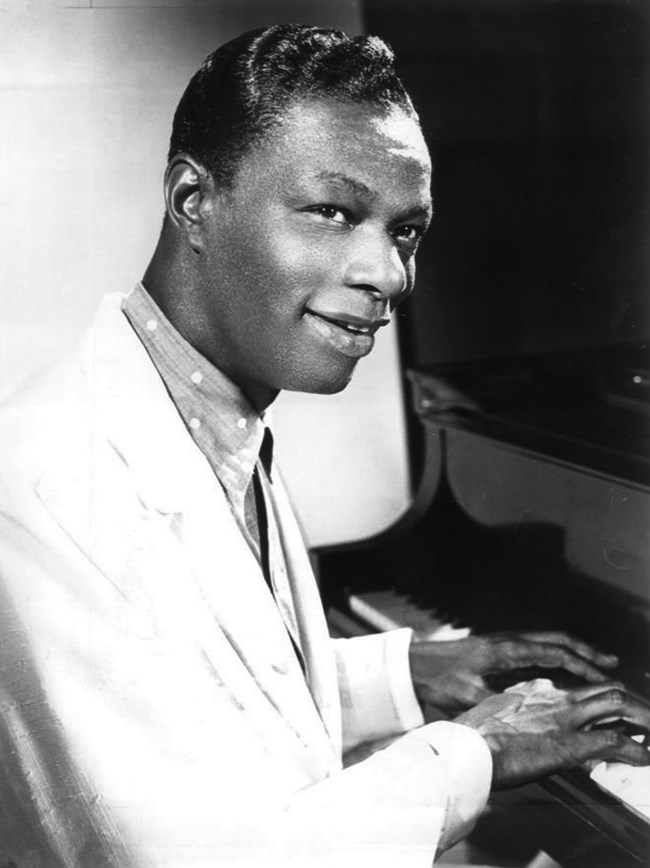Part of a series of articles titled The Watsons Go to Birmingham—1963.
Article
Chapter 7: Every Chihuahua in America Lines Up to Take a Bite out of Byron

"Barber and customer both with conked hair," New York Public Library Digital Collections, Schomburg Center for Research in Black Culture, Photographs and Prints Division, The New York Public Library.
Byron wears a hat as he tries to slip in the back door.
When he notices Momma and Kenny, he quickly turns around. Suspicious, Momma tells Byron he knows better than to wear a hat in the house and orders him to come inside. Before entering, Byron reluctantly removes his hat and handkerchief, revealing a new hairdo. Byron went behind his parents' back and got a conk, which means someone used chemicals to straighten his hair. Only now, it's reddish-brown and sticking straight up. Byron explains that he wanted "Mexican-style" hair and insists he looks cool.
Kenny can't wait to see what trouble awaits Byron. But Joey is worried. Byron assures her there is nothing their parents can do now—the conk is permanent, and they will just have to wait until it grows out. When Dad comes home, he calmly brings Byron into the bathroom, where he starts whistling Nat King Cole's song "Straighten Up and Fly Right," as he cuts off all of Bryon's hair. It didn't seem possible, but now Byron looks even funnier!
Dad tells Byron they've had enough, and it's time they do something about his misbehavior. Kenny and Joey go outside so Momma and Dad can have an adults-only talk. When they return, Momma and Dad are speaking on a long distance telephone call with Grandma Sands (Momma's mom), who lives in Birmingham, Alabama.

NBC Television, photograph, “Nat King Cole Show premiere 1956.”
Fact Check: What is a conk?
What do we know?
A conk is a hairstyle that was worn by some African American men between the 1940s and early 1960s. The name comes from congolene, a lye-based gel used to chemically straighten or "relax" hair. Once straightened, people styled their hair into pompadours or wore it slicked back. Getting a conk at the barber's was expensive, which is why some people conked their hair themselves, using a combination of lye, eggs, and potatoes. Lye, a strong chemical often used in soap, can irritate the skin and even cause severe burns if it is not quickly washed out. Adding to the cost and pain of the initial process, maintaining a conk is a lot of work, as chemicals must be reapplied as hair grows.
The conk was made famous by Black musicians like James Brown, Chuck Berry, and Little Richard, who wore their hair swept up into a swirl of waves on top of their heads. In addition to being trendy, the conk became a status symbol because having one showed you could afford to have your hair processed.
Conks became less popular in the 1960s, when the Black Pride and Black Power movements encouraged Black people to embrace their natural hair, rejecting white standards of beauty.
What is the evidence?
Primary source: NBC Television, photograph, "Nat King Cole Show premiere 1956."
Nat King Cole (with a conk) in the 1956 television premiere of The Nat King Cole Show. "Straighten Up and Fly Right" is one of Cole's best-known songs.
Primary source: Malcolm X and Alex Haley, The Autobiography of Malcolm X (New York: Grove Press, 1965).
In the autobiography he published after he had become famous as the leader of the Black Nationalist movement, Malcolm X looks back at his youth and describes the experience of getting his first conk. He acquired the nickname "Detroit Red" when he was living in Harlem. It was a reference to his conk (the process gave his hair a red tint) and the fact that he grew up in Michigan.
"He made me sit down, and he tied the string of the new rubber apron tightly around my neck, and combed up my bush of hair. Then, from the big Vaseline jar, he took a handful and massaged it hard all through my hair and into the scalp. He also thickly Vaselined my neck, ears and forehead. 'When I get to washing out your head, be sure to tell me anywhere you feel any little stinging,' Shorty warned me, washing his hands, then pulling on the rubber gloves, and tying on his own rubber apron. 'You always got to remember that any congolene left in burns a sore into your head.'
The congolene just felt warm when Shorty started combing it in. But then my head caught fire. I gritted my teeth and tried to pull the sides of the kitchen table together. The comb felt as if it was raking my skin off.
...This was my first really big step toward self-degradation: when I endured all of that pain, literally burning my flesh to have it look like a white man's hair. I had joined that multitude of Negro men and women in America who are brainwashed into believing that the black people are 'inferior'—and white people 'superior'一that they will even violate and mutilate their Godcreated bodies to try to look 'pretty' by white standards."
Secondary source: Maxine Craig, "The decline and fall of the conk; or, how to read a process," Fashion Theory: The Journal of Dress, Body, & Culture 1, no. 4 (1997): 399-419, https://doi.org/10.2752/136270497779613657.
"Depending upon one's perspective, a conk marked a man as hip, sexy, dangerous, or low-class. A few critics denounced conks as a sign of identification with the white race. This view, iconoclastic [rare in its criticism] before 1960, prevailed among African Americans in the mid-1960s and early 1970s. ...Before the emergence of the black consciousness movement, the conk had a variety of meanings. To poor black men and women it could represent sophistication and prosperity. Wearing a conk, one could be like the entertainers, who were virtually the only African Americans who received national recognition. To others it bore the stigma (or appeal) of its association with dangerous men. Some African Americans never accepted it as a legitimate expression of masculinity and saw it as a feminizing style. And to some it represented a desire to imitate whites. Present but not predominant [common] in the 1940s and 1950s, that view grew to eclipse all other readings of a conk."

Courtesy of the Associated Press (NY), June 11, 1943.
Fact Check: Why does Byron call his conk "Mexican-style" hair?
What do we know?
Beginning in the 1930s, some Mexican and Mexican American youth wore their hair in a pompadour style, often called a ducktail or duckbill. This style is similar in appearance to a conk.
Both African American and Mexican American youth used fashion, including dress and hairstyles, to express themselves and to rebel against authority. While fashion and style is not necessarily a form of political protest, it can be. We see this in what is called the Zoot Suit Riots, which took place in Los Angeles in 1943, during World War II. Violent clashes erupted between the uniformed military and civilian young people (primarily youth of color) wearing zoot suits and pompadour style hair.
Zoot suits (wide pants and shirt legs) used a lot of fabric, which was rationed and in short supply during the war. Importantly, both zoot suits and swept-up hairstyles also expanded the physical space a young person "took up" on the street, in public transportation, and in people's minds. The adoption of the zoot suit and pompadour hairstyle communicated a rejection of white middle-class standards of respectability ("we don't accept your dress code!") and for many who took on the style, it was an assertion of one's humanity and worth. It linked Mexican American and African American youth, two minoritized groups.
What is the evidence?
Primary Sources: "Zoot Suit truce," photograph, Associated Press (NY), June 11, 1943.
Secondary sources: Kathy Lee Peiss, Zoot Suit: The Enigmatic Career of an Extreme Style (Philadelphia: University of Pennsylvania Press, 2011).
"Mexican Americans were also ... early devotees of the zoot suit. 'It's nothing new,' actor Adolphe Menjou observed. 'The Mexicans in California have been wearing them for generations.' ...By 1940, many had adopted drape pants, with their high waists, full legs, and tight cuffs. Extreme zoot suiters went further, wearing large hats with a feather, long keychains, 'ankle chokers,' and fingertip jackets. ...Those who wore the full zoot suit ensemble embraced an identity as pachucos, combing their long hair in a 'duck bill' style, speaking a hybrid slang called caló, and organizing their everyday lives around social clubs and peer groups."
Secondary Sources: Holly Alford, "The Zoot Suit: its history and influence," Fashion Theory 8, no. 2 (2004): 225-36.
"Everything was exaggerated, from the V knot tie, the zoot chain, the tight collar, the wide flat hat, and the Dutch type shoes. The suit came in various colors, such as lime green or canary yellow, and many suits bore a plaid stripe, or hounds-tooth print. The zoot suit was but one part of a total look that included … the way you wore your hair... The hairstyle for African American men meant slicking back the hair so that it was nice and smooth ... Slicking the hair back was popular, as well, for Hispanic Americans."

John Maloney, "Zoot Suit Illustration," January 7, 1957, Herald Examiner Collection/Los Angeles Public Library.
Secondary source: Luis Alvarez, The power of the Zoot: youth culture and resistance during World War II (Berkeley: University of California Press, 2008).
"Zoot suit style was distinguished by much more than clothing, as many youth complemented their flamboyant apparel with distinctive hairdos and tattoos. Each of the various elements of zoot style helped nonwhite youth regain control over their own bodies, craft a public presence that demanded attention, and cultivate social practices often hard for outsiders to decipher. Zoot suiters challenged their dehumanization by taking great pride and care in their individual appearance and public personas. Like young pachucas with their pompadours, male Mexican American zoot suiters in Los Angeles had their own haircut of choice, according to one contemporary—'the hair style known as 'duck bill'—generous in length and combed toward the center in the back.' It was also not uncommon for Mexican American youth to employ 'tattooing and the wearing of chin hairs' to further distinguish their bodies.
Like their Mexican American counterparts, many young African American men added to their zoot appearance with special haircuts. Rather than the ducktail, however, many black youth were fond of the conk."

Voices from the Field
The Hidden History of By Watson’s “Conk” Style Haircut in The Watsons go to Birmingham-1963 by Luis Alvarez, a professor of history at the University of California, San Diego and the author of The Power of the Zoot: Youth Culture and Resistance during World War II.
Writing Prompts
Opinion
In the past, school and work dress codes included specific rules about hair style and length, usually differentiated by gender. Some schools and employers continue to have such rules while others have replaced them with more general policies (for example, hair should be “neat” and “clean”) and still others have eliminated them entirely. Are rules about hair appropriate? Who should be allowed to make the rules? State your opinion and provide reasons that are supported by facts and details.
Informative/explanatory
Learn more about the “conk” hairstyle and research the artists, singing groups, and celebrities that popularized the hairstyle. Develop the topic with facts and concrete details.
Narrative
“It all began when I wanted to…!” Create a narrative that begins with this phrase. Include the action, unfolding of events, and the eventual consequences. Orient the reader by establishing a situation and introducing the first-person narrator. Organize an event sequence that unfolds naturally. Provide a believable conclusion that follows from the event.
Note: Wording in italics is from the Common Core Writing Standards, Grade 5. Sometimes paraphrased.
Last updated: December 29, 2023
